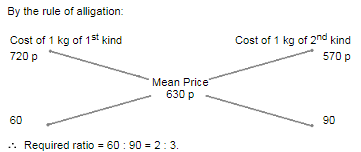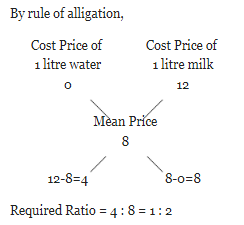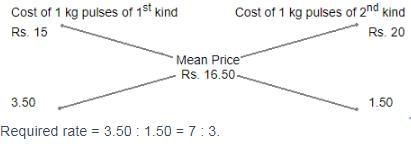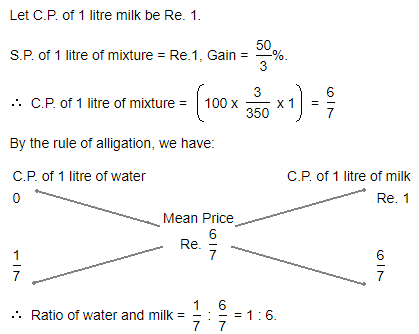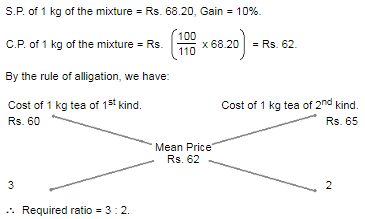All Exams >
UPSC >
CSAT Preparation >
All Questions
All questions of Mixtures & Alligations for UPSC CSE Exam
A jar is full of whiskey contains 40% alcohol. A part of this whiskey is replaced by another containing 19% alcohols and now the percentage of alcohol was found to be 26%. The quantity of whiskey replaced is:
a)4/3
b)3/4
c)3/2
d)2/3
Correct answer is option 'D'. Can you... more explain this answer?
|
|
Pritam Joshi answered |
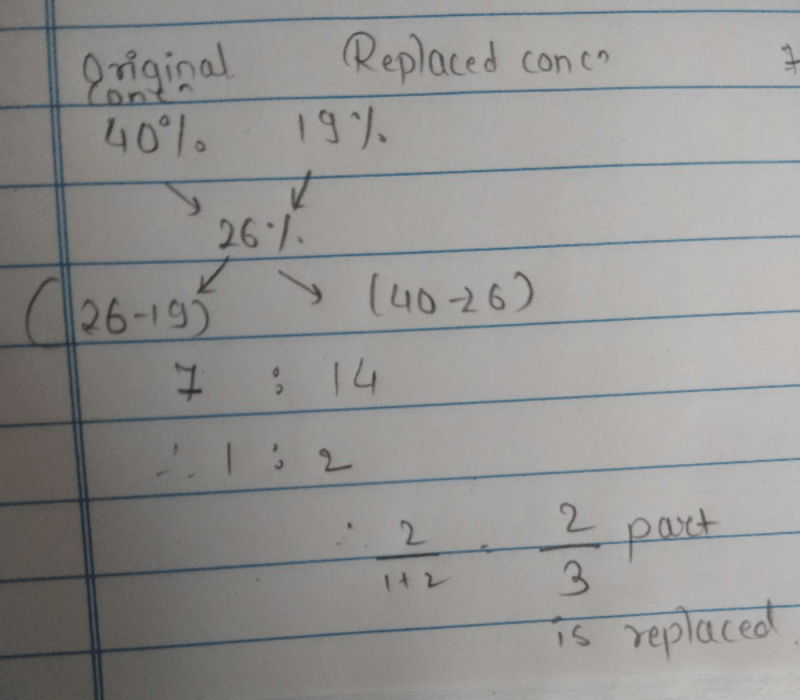
Practice Quizzes or MCQ (Multiple Choice Questions) with solution are available for Practice, which would help you prepare for Alligation or Mixture under Quantitative Aptitude. You can practice these practice quizzes as per your speed and improvise the topic. The same topic is covered under various competitive examinations like - CAT, GMAT, Bank PO, SSC and other competitive examinations. Q. A container contains 40 litres of milk. From this container 4 litres of milk was taken out and replaced by water. This process was repeated further two times. How much milk is now contained by the container?- a)26 litres
- b)29.16 litres
- c)28 litres
- d)28.2 litres
Correct answer is option 'B'. Can you explain this answer?
Practice Quizzes or MCQ (Multiple Choice Questions) with solution are available for Practice, which would help you prepare for Alligation or Mixture under Quantitative Aptitude. You can practice these practice quizzes as per your speed and improvise the topic. The same topic is covered under various competitive examinations like - CAT, GMAT, Bank PO, SSC and other competitive examinations.
Q. A container contains 40 litres of milk. From this container 4 litres of milk was taken out and replaced by water. This process was repeated further two times. How much milk is now contained by the container?
a)
26 litres
b)
29.16 litres
c)
28 litres
d)
28.2 litres

|
Raghavendra Sharma answered |
40M
After replacing
36M : 4W => 9:1
In the next replacement
Out of 4 Litres mixture
3.6L milk, 0.4L Water
Now, Milk => 32.4, Water => 7.6
i.e 4.26 : 1 => The current ratio of the mixture
Next 4 Litres in the above ratio
4/5.26= 0.76
0.76x4.26 = 3.239 (3.24)
32.4–3.24= 29.16 Litres of Milk
In what ratio must rice at Rs.7.10 be mixed with rice at Rs.9.20 so that the mixture may be worth Rs.8 per Kg?
- a)5 : 4
- b)2 : 1
- c)3 : 2
- d)4 : 3
Correct answer is option 'D'. Can you explain this answer?
a)
5 : 4
b)
2 : 1
c)
3 : 2
d)
4 : 3

|
Dhruv Mehra answered |
By the rule of alligation, we have
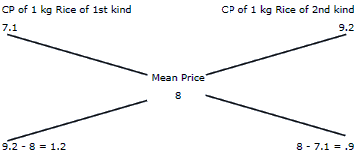
8 litres are drawn from a cask full of wine and is then filled with water. This operation is performed three more times. The ratio of the quantity of wine now left in cask to that of the water is 16:65. How much wine did the cask originally hold?
- a)30 litres
- b)26 litres
- c)24 litres
- d)32 litres
Correct answer is option 'C'. Can you explain this answer?
8 litres are drawn from a cask full of wine and is then filled with water. This operation is performed three more times. The ratio of the quantity of wine now left in cask to that of the water is 16:65. How much wine did the cask originally hold?
a)
30 litres
b)
26 litres
c)
24 litres
d)
32 litres

|
Arya Roy answered |
8 litres are drawn from a cask full of wine and is then filled with water.
This operation is performed three more times.
The ratio of the quantity of wine now left in cask to that of the water is 16 ∶ 65
Calculations:
Calculations:
Let the quantity of the wine in the cask originally be x litres.
After first operation, wine left in the cask = (x - 8) litres So, the ratio of the quantity of wine now left in cask to that of filled cask = 

This operation is performed three more times. Then, Wine : Water = 16 : 65 or wine : water = 16 : (16 + 65) = 81
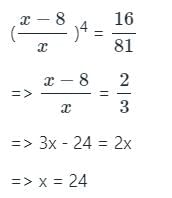

Correct answer is 24.
A mixture of 100 litres of spirit and alcohol contains 25% alcohol. How much more alcohol should be added to the mixture to increase the percentage of alcohol to 30% in the new mixture?
- a)3.33 litres
- b)7.14 litres
- c)5 litres
- d)4 litres
Correct answer is option 'B'. Can you explain this answer?
A mixture of 100 litres of spirit and alcohol contains 25% alcohol. How much more alcohol should be added to the mixture to increase the percentage of alcohol to 30% in the new mixture?
a)
3.33 litres
b)
7.14 litres
c)
5 litres
d)
4 litres

|
Kavya Sharma answered |
Alcohol content in the alcohol to be added = 100%
Therefore, the allegation diagram for this problem can be drawn as:
Therefore, the allegation diagram for this problem can be drawn as:
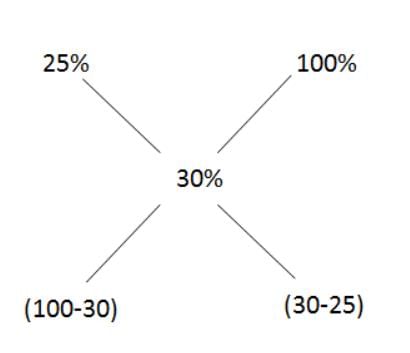
Therefore, ratio of the mixture to alcohol = 70/5 = 14/1
So, alcohol to be added = 100/14
So, alcohol to be added = 100/14
Hence, the answer is "7.14 litres".
Choice B is the correct answer.
How many kilograms of sugar costing Rs. 9 per kg must be mixed with 27 kg of sugar costing Rs. 7 per Kg so that there may be a gain of 10 % by selling the mixture at Rs. 9.24 per Kg ?
- a)60 Kg
- b)63 kg
- c)58 Kg
- d)56 Kg
Correct answer is option 'B'. Can you explain this answer?
a)
60 Kg
b)
63 kg
c)
58 Kg
d)
56 Kg

|
Pallabi Deshpande answered |
C.P. of 1 kg sugar of 1st kind C.P. of 1 kg sugar of 2nd kind


Therefore, Ratio of quantities of 1st and 2nd kind = 14 : 6 = 7 : 3.
Let x kg of sugar of 1st kind be mixed with 27 kg of 2nd kind.
Then, 7 : 3 = x : 27 or x = (7 x 27 / 3) = 63 kg.
A vessel is filled with liquid, 3 parts of which are water and 5 parts of syrup. How much of the mixture must be drawn off and replaced with water so that the mixture may be half water and half syrup? - a)1/3
- b)1/4
- c)1/5
- d)1/6
Correct answer is option 'C'. Can you explain this answer?
A vessel is filled with liquid, 3 parts of which are water and 5 parts of syrup. How much of the mixture must be drawn off and replaced with water so that the mixture may be half water and half syrup?
a)
1/3
b)
1/4
c)
1/5
d)
1/6

|
Raghavendra Sharma answered |
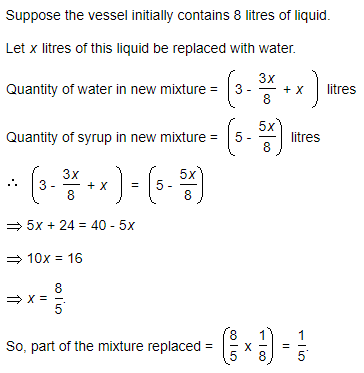
The cost of Type 1 material is Rs. 15 per kg and Type 2 material is Rs.20 per kg. If both Type 1 and Type 2 are mixed in the ratio of 2 : 3, then what is the price per kg of the mixed variety of material?- a)Rs. 19
- b)Rs. 16
- c)Rs. 18
- d)Rs. 17
Correct answer is option 'C'. Can you explain this answer?
The cost of Type 1 material is Rs. 15 per kg and Type 2 material is Rs.20 per kg. If both Type 1 and Type 2 are mixed in the ratio of 2 : 3, then what is the price per kg of the mixed variety of material?
a)
Rs. 19
b)
Rs. 16
c)
Rs. 18
d)
Rs. 17

|
Ishani Rane answered |
Let the price of the mixed variety be Rs. x per kg.
By rule of alligation, we have:
Therefore, (20 - x)/(x - 15) = 2/3
=> 60 - 3x = 2x - 30
=> 5x = 90
=> x = 18
Tea worth Rs. 126 per kg and Rs. 135 per kg are mixed with a third variety of tea in the ratio 1 : 1 : 2. If the mixture is worth Rs. 153 per kg, what is the price of the third variety per kg ?
- a)Rs.182.50
- b)Rs.170.5
- c)Rs.175.50
- d)Rs.180
Correct answer is option 'C'. Can you explain this answer?
a)
Rs.182.50
b)
Rs.170.5
c)
Rs.175.50
d)
Rs.180

|
Manoj Ghosh answered |
Since first and second varieties are mixed in equal proportions.
So, their average price = Rs. 126 + 135/2 = Rs. 130.50
So, the mixture is formed by mixing two varieties, one at Rs. 130.50 per kg and the other at say, Rs. x per kg in the ratio 2 : 2, i.e., 1 : 1. We have to find x.
By the rule of alligation, we have:
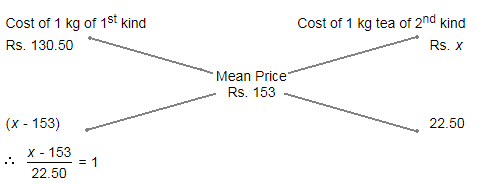
x - 153 = 22.50
x = 175.50
In what ratio must tea at Rs.62 per Kg be mixed with tea at Rs. 72 per Kg so that the mixture must be worth Rs. 64.50 per Kg?
- a)1 : 2
- b)2 : 1
- c)3 : 1
- d)1 : 3
Correct answer is option 'C'. Can you explain this answer?
a)
1 : 2
b)
2 : 1
c)
3 : 1
d)
1 : 3

|
Raghavendra Sharma answered |
C.P of a unit quantity of 1st kind = Rs. 62
C.P of a unit quantity of 2nd kind = Rs. 72
Mean price = Rs. 64.50
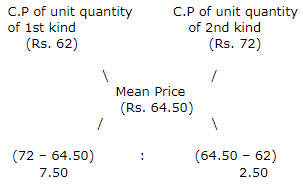
Required ratio = 7.50 : 2.50 = 3 : 1
A milk vendor has 2 cans of milk. The first contains 25% water and the rest milk. The second contains 50% water. How much milk should he mix from each of the containers so as to get 12 litres of milk such that the ratio of water to milk is 3 : 5?
- a)5 litres, 7 litres
- b)7litres, 4 litres
- c)6litres, 6 litres
- d)4litres, 8 litres
Correct answer is option 'C'. Can you explain this answer?
a)
5 litres, 7 litres
b)
7litres, 4 litres
c)
6litres, 6 litres
d)
4litres, 8 litres

|
Ishani Rane answered |
Let x and (12-x) litres of milk be mixed from the first and second container respectively
Amount of milk in x litres of the the first container = .75x
Amount of water in x litres of the the first container = .25x
Amount of milk in (12-x) litres of the the second container = .5(12-x)
Amount of water in (12-x) litres of the the second container = .5(12-x)
Ratio of water to milk = [.25x + .5(12-x)] : [.75x + .5(12-x)] = 3 : 5
⇒ (.25x+6-5x)/(.75x+6-.5x) =3/5
⇒(6−.25x)/(.25x+6) =3/5
⇒30−1.25x=.75x+18
⇒2x=12
⇒x=6
Since x = 6, 12-x = 12-6 = 6
Hence 6 and 6 litres of milk should mixed from the first and second container respectively
A container contains a mixture of two liquids P and Q in the ratio 7 : 5. When 9 litres of mixture are drawn off and the container is filled with Q, the ratio of P and Q becomes 7 : 9. How many litres of liquid P was contained in the container initially?
- a)23
- b)21
- c)19
- d)17
Correct answer is option 'B'. Can you explain this answer?
a)
23
b)
21
c)
19
d)
17

|
Gowri Chakraborty answered |

Two vessels A and B contain spirit and water in the ratio 5 : 2 and 7 : 6 respectively. Find the ratio in which these mixture be mixed to obtain a new mixture in vessel C containing spirit and water in the ration 8 : 5 ?
- a)3: 4
- b)4 : 3
- c)9 : 7
- d)7 : 9
Correct answer is option 'D'. Can you explain this answer?
a)
3: 4
b)
4 : 3
c)
9 : 7
d)
7 : 9

|
Manoj Ghosh answered |
Spirit in 1 litre mix of A = 5/7 litre.
Spirit in 1 litre mix of B = 7/13 litre.
Spirit in 1 litre mix of C = 8/13 litre.
By rule of alligation we have required ratio X:Y
X : Y
5/7 7/13
\ /
(8/13)
/ \
(1/13) : (9/91)
7 9
Therefore required ratio = 1/13 : 9/91
= 7:9
Chapter doubts & questions for Mixtures & Alligations - CSAT Preparation 2025 is part of UPSC CSE exam preparation. The chapters have been prepared according to the UPSC CSE exam syllabus. The Chapter doubts & questions, notes, tests & MCQs are made for UPSC CSE 2025 Exam. Find important definitions, questions, notes, meanings, examples, exercises, MCQs and online tests here.
Chapter doubts & questions of Mixtures & Alligations - CSAT Preparation in English & Hindi are available as part of UPSC CSE exam.
Download more important topics, notes, lectures and mock test series for UPSC CSE Exam by signing up for free.
CSAT Preparation
208 videos|138 docs|138 tests
|
Related UPSC CSE Content
Signup to see your scores go up within 7 days!
Study with 1000+ FREE Docs, Videos & Tests
10M+ students study on EduRev

Contact Support
Our team is online on weekdays between 10 AM - 7 PM
Typical reply within 3 hours
|
Free Exam Preparation
at your Fingertips!
Access Free Study Material - Test Series, Structured Courses, Free Videos & Study Notes and Prepare for Your Exam With Ease

 Join the 10M+ students on EduRev
Join the 10M+ students on EduRev
|

|
Forgot Password
OR
Signup to see your scores
go up within 7 days!
Access 1000+ FREE Docs, Videos and Tests
Takes less than 10 seconds to signup
